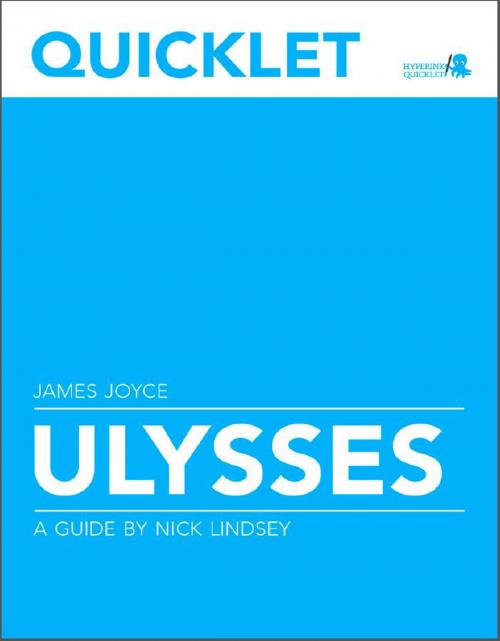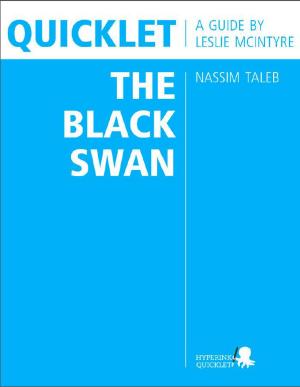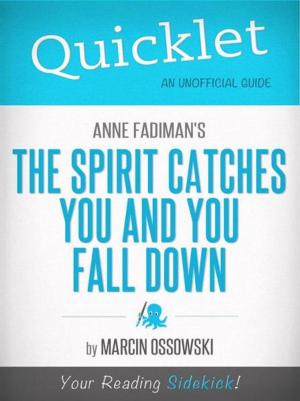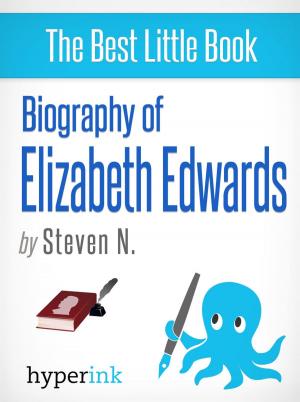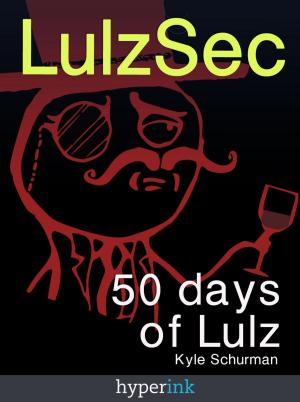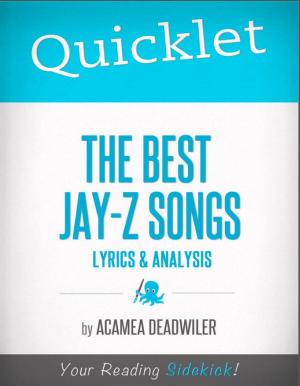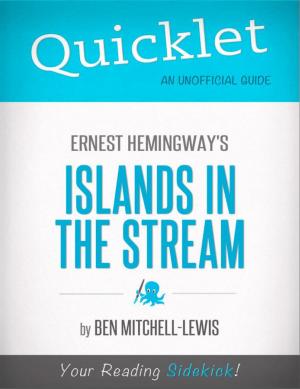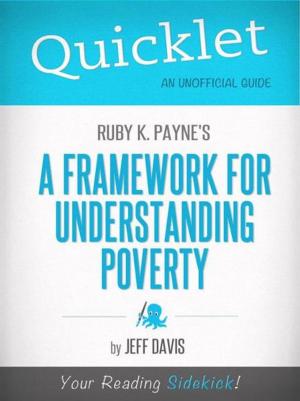Quicklet on James Joyce's Ulysses
Nonfiction, Reference & Language, Study Aids, Book Notes, Art & Architecture, General Art| Author: | Nick Lindsey | ISBN: | 9781614645184 |
| Publisher: | Hyperink | Publication: | July 30, 2012 |
| Imprint: | Hyperink | Language: | English |
| Author: | Nick Lindsey |
| ISBN: | 9781614645184 |
| Publisher: | Hyperink |
| Publication: | July 30, 2012 |
| Imprint: | Hyperink |
| Language: | English |
ABOUT THE BOOK
James Joyce was most definitely an artist ahead of his time; and, as is so often the case with prophetic characters of any sort, his ideas and works were met with some resistance by the general public. This is particularly true of Joyce’s masterpiece, Ulysses.
Beginning in March 1918, the first few episodes of Ulysses were serialized in the American journal, The Little Review. This continued until December 1920, when “members of the New York Society for the Suppression of Vice were shocked by the novel’s masturbation scene and took it upon themselves to block U.S. publication of the full work” (About, Top 10 “Obscene” Literary Classics).
For an audience still in many ways straddling the divide between the socially conservative sensibilities of the Victorian era and the newer notions of Modernism, Joyce’s novel must have seemed entirely scandalous, if not entirely incomprehensible. Throughout its pages, the narrative provides a detailed and persistent account of its protagonists’ activities over the course of a single day. It follows them wherever they go, whether it be to the beach, the brothel, a funeral, the newspaper office, the hospital, or the outhouse. The details regarding these locations, and especially the activities and events that occur at each, are presented unapologetically and candidly.
In 1921, when the published chapters of Ulysses were taken to court in the United States, the material was officially declared obscene, and any future publication of the full-length novel in the U.S. was banned. Around this same time, the United Kingdom reached a similar conclusion, also barring publication of the novel.
EXCERPT FROM THE BOOK
For an audience still in many ways straddling the divide between the socially conservative sensibilities of the Victorian era and the newer notions of Modernism, Joyce’s novel must have seemed entirely scandalous, if not entirely incomprehensible. Throughout its pages, the narrative provides a detailed and persistent account of its protagonists’ activities over the course of a single day. It follows them wherever they go, whether it be to the beach, the brothel, a funeral, the newspaper office, the hospital, or the outhouse. The details regarding these locations, and especially the activities and events that occur at each, are presented unapologetically and candidly.
In 1921, when the published chapters of Ulysses were taken to court in the United States, the material was officially declared obscene, and any future publication of the full-length novel in the U.S. was banned. Around this same time, the United Kingdom reached a similar conclusion, also barring publication of the novel.
Responding to the legal injunctions forbidding the publication of Ulysses in either the U.S. or Great Britain, Joyce published his novel in Paris in 1922. After this initial publication, it took 11 more years before Joyce was able to publish openly and freely in other countries.
In 1933, the American publishing company, Random House, along with prominent American lawyer, Morris Ernst, arranged to have a French copy of the novel sent to the United States, which would be seized by customs upon arrival. The seizure occurred according to their plan, and they immediately challenged the act, calling into question the legitimacy of the entire ban against Ulysses.
On December 6, 1933, U.S. District Judge John M. Woolsey ruled that the novel was not pornographic, and therefore, was not obscene. This ruling was affirmed by the Second Circuit Court of Appeals in 1934, and the ban on publication was lifted. Shortly thereafter, in 1936, the United Kingdom also lifted its ban...
...buy the book to read more!
ABOUT THE BOOK
James Joyce was most definitely an artist ahead of his time; and, as is so often the case with prophetic characters of any sort, his ideas and works were met with some resistance by the general public. This is particularly true of Joyce’s masterpiece, Ulysses.
Beginning in March 1918, the first few episodes of Ulysses were serialized in the American journal, The Little Review. This continued until December 1920, when “members of the New York Society for the Suppression of Vice were shocked by the novel’s masturbation scene and took it upon themselves to block U.S. publication of the full work” (About, Top 10 “Obscene” Literary Classics).
For an audience still in many ways straddling the divide between the socially conservative sensibilities of the Victorian era and the newer notions of Modernism, Joyce’s novel must have seemed entirely scandalous, if not entirely incomprehensible. Throughout its pages, the narrative provides a detailed and persistent account of its protagonists’ activities over the course of a single day. It follows them wherever they go, whether it be to the beach, the brothel, a funeral, the newspaper office, the hospital, or the outhouse. The details regarding these locations, and especially the activities and events that occur at each, are presented unapologetically and candidly.
In 1921, when the published chapters of Ulysses were taken to court in the United States, the material was officially declared obscene, and any future publication of the full-length novel in the U.S. was banned. Around this same time, the United Kingdom reached a similar conclusion, also barring publication of the novel.
EXCERPT FROM THE BOOK
For an audience still in many ways straddling the divide between the socially conservative sensibilities of the Victorian era and the newer notions of Modernism, Joyce’s novel must have seemed entirely scandalous, if not entirely incomprehensible. Throughout its pages, the narrative provides a detailed and persistent account of its protagonists’ activities over the course of a single day. It follows them wherever they go, whether it be to the beach, the brothel, a funeral, the newspaper office, the hospital, or the outhouse. The details regarding these locations, and especially the activities and events that occur at each, are presented unapologetically and candidly.
In 1921, when the published chapters of Ulysses were taken to court in the United States, the material was officially declared obscene, and any future publication of the full-length novel in the U.S. was banned. Around this same time, the United Kingdom reached a similar conclusion, also barring publication of the novel.
Responding to the legal injunctions forbidding the publication of Ulysses in either the U.S. or Great Britain, Joyce published his novel in Paris in 1922. After this initial publication, it took 11 more years before Joyce was able to publish openly and freely in other countries.
In 1933, the American publishing company, Random House, along with prominent American lawyer, Morris Ernst, arranged to have a French copy of the novel sent to the United States, which would be seized by customs upon arrival. The seizure occurred according to their plan, and they immediately challenged the act, calling into question the legitimacy of the entire ban against Ulysses.
On December 6, 1933, U.S. District Judge John M. Woolsey ruled that the novel was not pornographic, and therefore, was not obscene. This ruling was affirmed by the Second Circuit Court of Appeals in 1934, and the ban on publication was lifted. Shortly thereafter, in 1936, the United Kingdom also lifted its ban...
...buy the book to read more!
